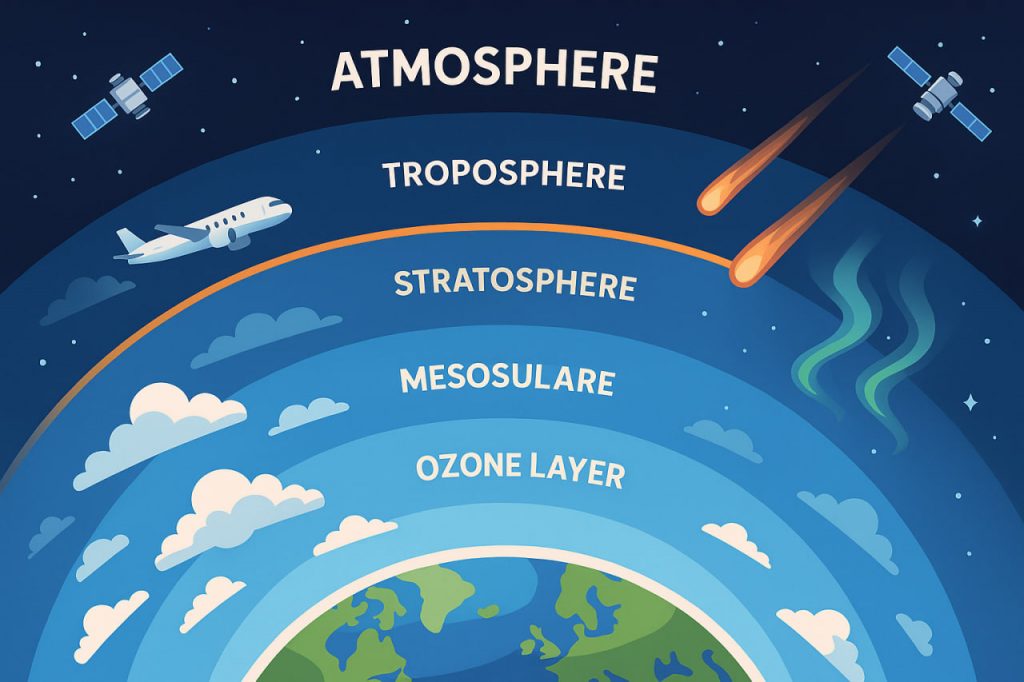The atmosphere is one of Earth’s most vital and fascinating features — an invisible ocean of gases surrounding our planet, protecting it from harmful space radiation, regulating temperature, and sustaining all living beings. Without the atmosphere, Earth would be a barren, frozen world, exposed to deadly solar radiation and devoid of breathable air. Understanding how this fragile layer works helps us appreciate its importance and recognize the need to protect it from pollution and climate change.
What Is the Atmosphere Made Of?
Earth’s atmosphere is composed of a delicate mixture of gases that make life possible. Approximately 78% is nitrogen (N₂), 21% is oxygen (O₂), and the remaining 1% consists of argon, carbon dioxide, neon, helium, and trace gases.
Tiny particles such as dust, pollen, salt, and water vapor are also suspended in the air, influencing weather and climate. The balance of these components is crucial — too little oxygen or too much carbon dioxide could make the planet uninhabitable.
The Layers of the Atmosphere
The atmosphere is divided into five main layers, each serving a unique role in maintaining life and weather patterns:
- Troposphere
- The lowest layer, where we live and breathe.
- Contains most of the atmosphere’s mass and all weather phenomena (clouds, rain, storms).
- Extends up to about 12 kilometers above the surface.
- Stratosphere
- Home to the ozone layer, which absorbs harmful ultraviolet (UV) radiation from the Sun.
- Airplanes often fly here to avoid turbulence.
- Temperature increases with altitude due to ozone absorption of sunlight.
- Mesosphere
- Extends up to about 85 kilometers.
- The coldest part of the atmosphere, where meteors burn up upon entry.
- Thermosphere
- Reaches up to 600 kilometers.
- Extremely hot due to solar radiation absorption, but thin enough that it wouldn’t feel warm.
- The auroras (northern and southern lights) occur here.
- Exosphere
- The outermost layer, gradually blending into space.
- Contains sparse hydrogen and helium atoms.
The Role of the Atmosphere
The atmosphere performs several essential functions that make Earth habitable:
- Protection: It blocks harmful solar and cosmic radiation.
- Temperature Regulation: Greenhouse gases trap some heat, keeping Earth’s surface warm enough for liquid water.
- Breathable Air: It supplies oxygen for respiration and carbon dioxide for photosynthesis.
- Weather and Water Cycle: It enables clouds, precipitation, and wind — essential for climate balance and agriculture.
The Delicate Balance: Human Impact
Human activity has altered the composition and stability of the atmosphere. Burning fossil fuels releases carbon dioxide (CO₂), methane (CH₄), and other greenhouse gases, intensifying the greenhouse effect and driving global warming.
Air pollution from industry and vehicles also damages the ozone layer and contributes to acid rain and respiratory illnesses.
Protecting the atmosphere requires global cooperation:
- Transitioning to renewable energy sources.
- Reducing emissions and deforestation.
- Supporting reforestation and sustainable agriculture.
The Future of Earth’s Atmosphere
If humanity acts responsibly, we can maintain a stable climate and clean air for generations. Advances in atmospheric research, space observation, and environmental policy give hope that this vital protective layer can endure — but only if we respect its limits.
Interesting Facts
- The total mass of Earth’s atmosphere is about 5.15 quadrillion tons.
- About 10 tons of meteor dust enter the atmosphere every day — most of it burns up.
- If compressed at sea level, the atmosphere would form a layer only 10 meters thick.
- The ozone layer absorbs around 97–99% of the Sun’s ultraviolet radiation.
- Human lungs exchange about 10,000 liters of air per day — proof of how deeply we depend on this fragile system.
Glossary
- Ozone Layer — a region of the stratosphere rich in ozone gas that protects Earth from ultraviolet radiation.
- Greenhouse Effect — the process by which gases trap heat in Earth’s atmosphere.
- Troposphere — the lowest layer of the atmosphere where weather occurs.
- Aurora — natural light display caused by charged particles interacting with Earth’s magnetic field.
- Carbon Dioxide (CO₂) — a greenhouse gas produced by respiration and human activity.


